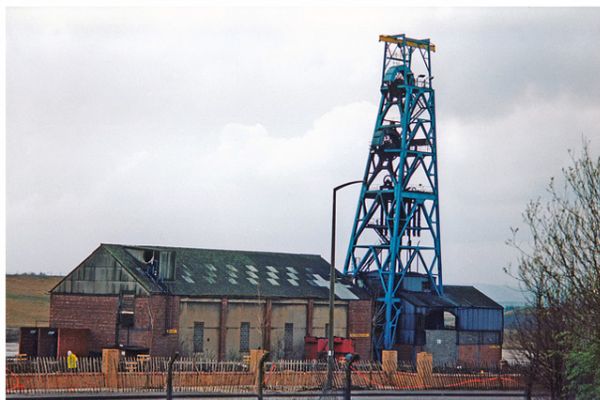
Hickleton Colliery
Copyright © Darren Haywood
The Hickleton Main Coal Co. began sinking two shafts to the Barnsley seam in December 1892. They were completed at a depth of 492 metres in June 1894. No.1 shaft had a steel headgear, but that on No.2 was made of timber. Having caught fire in 1898 it too was replaced with a steel structure. The colliery was also included with a brickworks and coke ovens.
A third shaft was sunk to a total depth of 848 metres between 1921 and 1923, but was backfilled to a little below the Thorncliffe seam. No.2 shaft was also deepened and the Parkgate seam, at 789 yards, was worked from 1925 to 1982.
In 1937 the Hickleton Main Co. became part of Doncaster Amalgamated Collieries Ltd and was able to benefit from a rationalisation of the way colliery takes were distributed.
Two new seams, above the Barnsley, were proved by drifts in the mid-1930s, but not developed in the early 1940s. The Newhill seam, with 1.42 metres of coal and two, thin dirt bands, was opened in 1941. After one year work in the seam was suspended, but resumed briefly in 1944, and again in 1950. This seam, at a depth of 329 metres, was at first called the High Main, then worked until 1982. The Meltonfield seam, with 1.2 metres of coal at 352 metres, opened in 1943 and was at first called the Low Main. It was worked until 1982.
Below the Barnsley seam, coal getting in the Dunsil seam began in 1941 and ran until 1974. The last Barnsley coal was worked in May 1956, but this was compensated by the NCB’s investment in loco-hauled mine cars and a new joint pit bottom to improve output from the Newhill and Meltonfield workings. Power loading was also introduced in the 1950s.
The surface plant was renewed in the 1960s, with electric winders replacing steam on Nos 1 and 2 shafts, new headgear on both shafts, and skips in No.2 shaft. Hickleton also got one of the first rapid loading bunkers in 1961. A new mine car circuit was installed in No. Shaft pit bottom.
Between 1967 and 1969 a 1417 metre long drift was driven from the surface at Hickleton to meet the combined Goldthorpe – Highgate workings. This drift then served as a common return airway.
The end of working in the Newhill and Meltonfield seams in 1982/3 concentrated work on deeper Parkgate and Thorncliffe seams, plus development of the Silkstone. Adverse geology, combined with the NUM strike, led to the abandonment of the Thorncliffe face and the mine was placed on development only status in the Parkgate seam.
In January 1986 Highgate was merged with Goldthorpe and kept open on a ‘care and maintenance’ status. It was closed in 1988, with the shafts being filled and the site cleared between 1991 and 1994.
Further reading:
- NMRS Records, Gazetteer of British Collieries
- Hill, A. The South Yorkshire Coalfield: A History and Development (Stroud: Tempus, 2002)
- Hill, A. Colliery Ventilation (Matlock: Peak District Mines Historical Society Ltd, 2000)
- Hill, A. Coal: A Chronology for Britain (NMRS, British Mining No.94, 2012)
- NUM Report to Annual Conference, 1984

